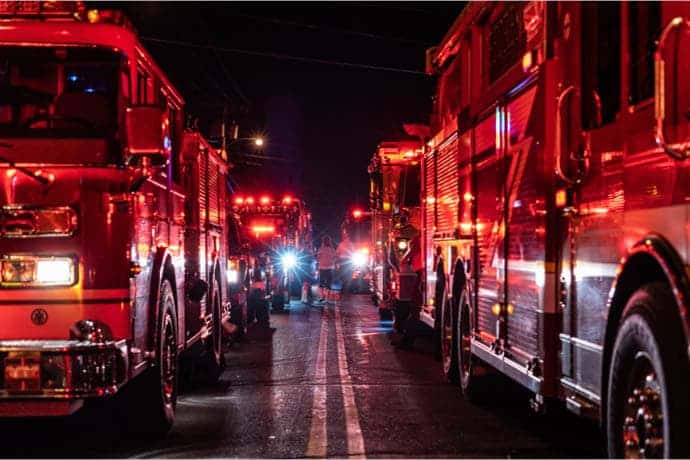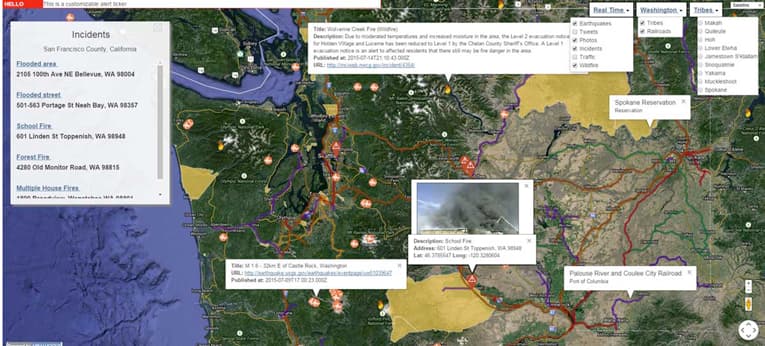How the New ‘Smart City’ Tackles Disaster Management with Open Data and Civic Tech

Leveraging open data and civic tech resources to foster agile solutions adapted to your unique needs can be a highly effective and affordable way to better anticipate, respond to, and recover from disasters.
To date, smart city initiatives have been largely top down efforts accompanied by hefty infrastructure investments. They’ve also targeted similar areas for improvements, like parking, street lighting, transportation, water and energy use, and waste management. Disaster management supported with open data and Civic Tech is emerging as a new paradigm.
However, in “The next-generation city: Resilient, smart and sustainable”, Jennifer Baljko aptly notes that there is a shift afoot in smart city thinking. New models and new types of concerns are being addressed, she observes, such as “climate proofing, citizen enablement and empowerment, disaster planning and recovery, information access, quality of life gains, resiliency, social equality, sustainability, technology justice and urban competitiveness infrastructure.”
Disaster Management with Open Data Rising to the Forefront
With natural disasters due to extreme weather events on the rise globally, and manmade disasters of increasing concern, it’s not surprising that Baljko observes that among these new types of smart city concerns, disaster management in particular is gaining interest.
Not content to rely solely on top-down national solutions, local communities are seeking smarter ways of anticipating, responding to, and recovering from disasters on their own, and these solutions often involve lighter investments than typical smart city initiatives. For instance, in Mozambique, two small cities developed a simple SMS text messaging system to warn about coming storms and provide residents with timely emergency preparation and response information. Now this local solution will be rolled out nationwide.
Other trends on the rise include greater community involvement in disaster management activities, and a focus on fostering sustainable economic development for local communities through the course of these activities.
A Win-Win for Communities
This evolution can be seen in the way civic tech organizations are using open data to craft local solutions to disaster management challenges. They are beginning to play an important role in boosting disaster management capabilities for cities and towns with tight budgets, engaging residents in disaster management efforts, and promoting economic resilience either through the start-up development based upon civic tech projects, or through a focus on solutions that dovetail disaster recovery efforts with strengthening local economies. Here are just a few of many examples:
One Concern, Inc.

Developed by three Stanford students, One Concern Inc.’s solutions use open data and artificial intelligence to help pinpoint specific areas and buildings which are likely to be hardest hit by an earthquake, saving precious minutes otherwise spent trying to prioritize resources based on floods of incoming 911 calls. In “An Earthquake Response System That’s Faster Than 911,” Julian Spector explains:
“The algorithm analyzes how buildings behaved in past quakes and supplements that with data on soil, nearby water bodies, structure ages, recent building improvements, and more. This generates a heat map of buildings more likely to be damaged than others.”
The program also takes the time of day and population numbers into account to aid in prioritizing resources.
Ushahidi
Start-up Ushahidi takes a slightly different approach. They’ve created an open source project which allows users to crowdsource crisis information to be sent via mobile phones. This raw data from crowds is mixed with open data to produce maps that aid response teams. Originally developed to map reports of violence in Kenya after the post-election violence in 2008, the Ushahidi solution helped 4,000 volunteers map out roads in Kathmandu that had been destroyed by the Nepal earthquake in April 2015.
Appallicious

A third example comes from San Francisco-based Appallicious. Built on open data, their Disaster Assessment and Assistance Dashboard (DAAD) helps communities, businesses, and governments share vital information and resources in the aftermath of a disaster, including a shareable marketplace that helps residents repair damage while accelerating economic recovery. As Appallicious CEO Yo Yoshida explains in “After the Disaster: Civic Startups to the Rescue”: “We believe communities benefit the most when they are able to rebuild locally. DAAD makes it possible for federal and local governments to funnel recovery dollars directly to local businesses in the wake of a disaster.”
Stimulating Disaster Management Innovation in Your Community
If you are a government official who would like to foster start-up innovation to aid in your disaster management efforts, here are three essential steps to get the ball rolling.
1/ Open Your Data
If you haven’t done so yet, now is the time to make your data available to the public. While some data related to disaster management comes from national sources (e.g., weather, geological and demographic data), local open data (e.g., on infrastructure, buildings, residences, businesses, traffic, etc.) is essential in creating or adapting applications to serve the unique needs of your community.
2/ Support Streaming Sensor Data & Provide APIs
If you are in the process of selecting or upgrading an open data portal for publishing your data, be sure it can natively handle real-time data streaming data to accommodate sensor data related to core services like electricity, traffic and public transit, emergency services and water systems. Real-time insight into these resources is essential for effective emergency response and recovery. (You’ll need to work with your energy, transportation and utility partners to ensure relevant data from their systems is made available to the public and developers alongside your own.)Standard, easy-to-use APIs are also essential. Developers need the reliable, always-on connection to up-to-date data that APIs provide to build applications.
3/ Develop a Community Animation and Governance Plan
Making your data available is just the first step. To stimulate the development of applications, you need a plan to get a community of data reusers engaged. Work with local universities, clubs, start-up networks and emergency services volunteers to identify those interested in both civic tech and disaster management efforts. Sponsor disaster management-themed hackathons, workshops, competitions, and university projects. Sponsor MeetUp groups and engage the community in the effort via social media. For further ideas, groups like the open data Institute have helpful resources on engaging with reusers on their sites, and can point you to additional resources.
To understand best practices for data governance, that is say for managing the availability, usability, integrity, and security of your data, take a look at Govlab’s open data Governance wiki and Gartner’s public report “open data Governance Is Key to Building a Smart City.”
While the cities and towns will always need financial, expertise, and manpower support from regional, national and sometimes even international agencies in order to cope with major disasters, leveraging open data and civic tech resources to foster agile solutions adopted to your unique needs can be a highly effective and affordable way to better anticipate, respond to, and recover from disasters.

Every municipality and its stakeholders will benefit from effectively sharing data. However smaller, resource-constrained cities with limited budgets can find it difficult to start their data sharing programs - we look at how partnering with other local organizations can help them begin.



